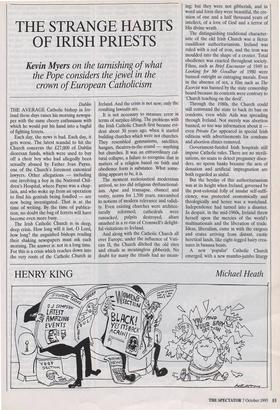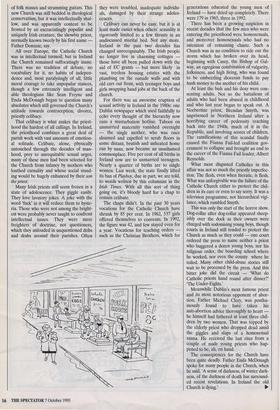THE STRANGE HABITS OF IRISH PRIESTS
Kevin Myers on the tarnishing of what
the Pope considers the jewel in the crown of European Catholicism
Dublin THE AVERAGE Catholic bishop in Ire- land these days raises his morning newspa- per with the same cheery enthusiasm with which he would put his hand into a bagful of fighting ferrets.
Each day, the news is bad. Each day, it gets worse. The latest scandal to hit the Church concerns the £27,000 of Dublin diocesan funds, which were used to buy off a choir boy who had allegedly been sexually abused by Father Ivan Payne, one of the Church's foremost canonical lawyers. Other allegations — including one involving a boy in the National Chil- dren's Hospital, where Payne was a chap- lain, and who woke up from an operation to find his genitals being fondled — are now being investigated. That is at the time of writing. By the time of publica- tion, no doubt the bag of ferrets will have become even more busy.
The Irish Catholic Church is in deep, deep crisis. How long will it last, 0 Lord, how long? the anguished bishops reading their shaking newspapers must ask each morning. The answer is: not in a long time. For this is a crisis which reaches down into the very roots of the Catholic Church in Ireland. And the crisis is not new; only the resulting lawsuits are. It is not necessary to measure error in terms of surplice-lifting. The problems with the Irish Catholic Church first became evi- dent about 30 years ago, when it started building churches which were not churches. They resembled gymnasiums, satellites, hangars, theatres-in-the-round — anything but churches. It was an extraordinary cul- tural collapse, a failure to recognise that in matters of a religion based on faith and obedience form is substance. What some- thing appears to be, it is. The moment ecclesiastical modernism arrived, so too did religious dysfunctional- ism. Apse and transapse, chancel and vestry, norms for 1,500 years, succumbed to notions of modern relevance and validi- ty. Even existing churches were architec- turally reformed; cathedrals were ransacked, pulpits destroyed, altars smashed in a re-run of Cromwell's delight- ful visitations to Ireland.
And along with the Catholic Church all over Europe, under the influence of Vati- can II, the Church ditched the old rites and rituals as meaningless gibberish. No doubt for many the rituals had no mean-
ing; but they were not gibberish, and in word and form they were beautiful, the cre- ation of one and a half thousand years of intellect, of a love of God and a terror of His divine wrath.
The distinguishing traditional character- istic of the old Irish Church was a fierce caudilloist authoritarianism. Ireland was ruled with a rod of iron, and the iron was moulded into the shape of a crozier. Total obedience was exacted throughout society. Films, such as Brief Encounter of 1949 to Looking for Mr Goodbar of 1980 were banned outright as outraging morals. Even in the absence of sex, a film such as The Exorcist was banned by the state censorship board because its contents were contrary to 'Church teaching on the devil'.
Through the 1980s, the Church could still command the state to back its ban on condoms, even while Aids was spreading through Ireland. Not merely was abortion banned, so too was information about it — even Private Eye appeared in special Irish editions with advertisements for condoms and abortion clinics removed.
Government-funded Irish hospitals still impose Catholic rules. There are no steriIi- sations, no scans to detect pregnancy disor- ders, no sperm banks because the acts of donation and artificial impregnation are both regarded as sinful.
But the heyday of this authoritarianism was at its height when Ireland, governed by the post-colonial folly of insular self-suffi- ciency, was protected economically and theologically and hence was a wasteland. Independence had turned into a disaster. In despair, in the mid-1960s, Ireland threw herself upon the mercies of the world's multinationals and the liberation of trade. Ideas, liberalism, came in with the cargoes and crates arriving from distant, exotic heretical lands, like eight-legged hairy crea- tures in banana boats.
A new 'popular' Catholic Church emerged, with a new mumbo-jumbo liturgy of folk masses and strumming guitars. This new Church was still bedded in theological conservatism, but it was intellectually shal- low, and was apparently content to be fronted by an excruciatingly populist and uniquely Irish creature, the showbiz priest, normally known tweely by his first name — Father Dominic, say.
All over Europe, the Catholic Church was in intellectual turmoil, but in Ireland the Church remained suffocatingly inane. There was no tradition of debate, no vocabulary for it, no habits of indepen- dence and, most paralysingly of all, little moral courage to take unpopular stances, though a few extremely intelligent and able theologians like Sean Freyne and Enda McDonagh began to question many absolutes which still governed the Church's attitude towards contraception, divorce, priestly celibacy.
That celibacy is what makes the priest- hood the hardest of all callings. In Ireland, the priesthood combines a great deal of parish work with vast amounts of emotion- al solitude. Celibate, alone, physically untouched through the decades of man- hood, prey to unrequitable sexual urges, many of these men had been selected for the Church from infancy by mothers who loathed carnality and whose social stand- ing would be hugely enhanced by their son the priest.
Many Irish priests still seem frozen in a state of adolescence. They giggle easily. They love lavatory jokes. A joke with the word 'fuck' in it will reduce them to hyste- ria. Those who were not among the bright- est were probably never taught to confront intellectual issues. They were mere freighters of doctrine, not questioners, which they unloaded in unquestioned dribs and drabs around their parishes. Often they were troubled, inadequate individu- als, damaged by their strange adoles- cence& Celibacy can never be easy, but it is at least made easier when others' sexuality is rigorously limited to a few thrusts in an undiscussed marital bed. Not any more. Ireland in the past two decades has changed unrecognisably. The Irish people no longer live in charming cottages — those have all been pulled down with the aid of EC grants — but more likely in vast, treeless housing estates with the plumbing on the outside walls and with old cars out front, with teenager boys and girls swapping hand jobs at the back of the church.
For there was an awesome eruption of sexual activity in Ireland in the 1980s: one Dublin newspaper which used faithfully to echo every thought of the hierarchy now runs a masturbation hotline. Taboos on unmarried maternity vanished overnight — the single mother, who was once shunned and expelled to scrub floors in some distant, brutish and unheated home run by nuns, now became an unashamed commonplace. Five per cent of all births in Ireland now are to unmarried teenagers. Nearly a quarter of births are to single women. Last week, the state finally lifted its ban of Playboy, due in part, we are told, to words written by this columnist in the Irish Times. With all this sort of thing going on, it's bloody hard for a chap to remain celibate.
The chaps didn't. In the past 30 years vocations for the Catholic Church have shrunk by 85 per cent. In 1962, 537 girls offered themselves to convents. In 1992, the figure was 42, and few stayed even for a year. Vocations for teaching orders — such as the Christian Brothers, which for generations educated the young men of Ireland — have dried up completely. There were 179 in 1965, three in 1992.
There has been a growing suspicion in recent decades that the few men who were entering the priesthood were homosexuals, and moreover homosexuals who had no intention of remaining chaste. Such a Church was in no condition to ride out the storm which has broken over its head, beginning with Casey, the Bishop of Gal- way, an egregious combination of vulgarity, folksiness, and high living, who was found to be embezzling diocesan funds to pay hush money to the mother of his child.
At least the bish and his doxy were con- senting adults. Not so the battalions of adults who had been abused in childhood and who last year began to speak out. A Norbertine priest, Brendan Smyth, was imprisoned in Northern Ireland after a horrifying career of pederasty reaching back into the 1940s, much of it in the Republic, and involving scores of children. The ramifications of this scandal finally caused the Fianna Fail-led coalition gov- eminent to collapse and brought an end to the career of the Fianna Fail leader, Albert Reynolds.
What most disgusted Catholics in this affair was not so much the priestly imperfec- tion. The flesh, even when hieratic, is flesh. What was unforgivable was the failure of the Catholic Church either to protect the chil- dren in its care or even to say sorry. It was a television programme, not hierarchical vigi- lance, which rumbled Smyth.
This was only the start of the horror show. Dog-collar after dog-collar appeared sheep- ishly over the dock as their owners were charged with sodomising young boys, though courts in Ireland still tended to protect the Church as much as they could — one court ordered the press to name neither a priest who buggered a dozen young boys, nor his religious order, the boarding school where he worked, nor even the county where he toiled. Many other child-abuse stories still wait to be processed by the press. And this bitter joke did the circuit — 'What do Catholic priests hand round after dinner?' 'The Under-Eights.'
Meanwhile Dublin's most famous priest and its most notorious opponent of abor- tion, Father Michael Clery, was posthu- mously found to have taken his anti-abortion advice thoroughly to heart — he himself had fathered at least three chil- dren by two women. That was topped by the elderly priest who dropped dead amid the giggles and slaps of a homosexual sauna. He received the last rites from a couple of nude young priests who hap- pened to be, ah, on hand.
The consequences for the Church have been quite deadly. Father Enda McDonagh spoke for many people in the Church, when he said, 'A sense of darkness, of winter dark- ness, of the darkness of death has surround- ed recent revelations. In Ireland the old Church is dying.' Bishop Kirby of Clonfert says that he sees a complete break-up of the old Irish sense of community in which the Church is the centre of social life. And he is right. Instead of Irish people no longer having the courage or the vocabulary to talk about religion, they now no longer have the interest.
The Jesuit magazine Studies attacked the church authorities for their handling of the recent crises, accusing them of 'ineptitude and dishonesty' and of covering up of wrongdoing. The editor, Father Noel Bar- ber, noted that many Catholics were dis- mayed that the institution they loved, and which was part of their very identity, had perpetrated such wicked deeds.
Few people in Ireland now trust in the intellectual and moral integrity of leaders of the Church. And yet outwardly Ireland remains the most Catholic country in Europe. Over 80 per cent of Catholics still go to mass once a week, regardless of what they were doing the night before. I know so many people who think nothing of spending Saturday night in revelry with a stranger or two, but will stagger out of bed on Sunday to attend mass and maybe even communion — Vatican II seems to have done a perfectly splendid job of ridding the Catholic Church in Ireland, as else- where, of a sense of sin or a belief in Hell.
Even now, 60 per cent of young people go to mass each Sunday — a weekly pop- ulation movement to vast barns of churches, surrounded by hundreds of badly parked cars. Any journey on a Sun- day morning through Ireland is like encountering scores of weddings in any other country. What communal reassur- ances do the participants give one another in these shuffling displays of public piety? Is mass-attendance some gregarious manifestation of a still not- understood need for bonding unique to Irish life?
Pope John Paul Il has always taken a vigorous interest in the Irish Church. He feels it is the jewel in the crown of Euro- pean Catholicism, and he has foisted on it conservative and authoritarian bishops with little pastoral experience whose job is to undo the liberalising damage done by Vatican II. In this they will fail. The genie is uncorked.
The Irish Church is now fighting desper- ate rearguard actions against the legalisa- tion of divorce and the right to have information on abortion overseas. Unlike previous battles in the 1980s, the Church now has no party political allies in the Dail. Worse still, many of its infantry have been incapacitated or demoralised by the recent scandals. Hundreds of good priests have fled in despair.
And the hierarchy itself is bitterly riven — more bitterly than anything in living memory — on the issue of discussing cleri- cal celibacy. One bishop in favour is now being dried out in exile in America, with all sorts of unfragrant rumours about his private life circulating. A Polish mitre is menacingly visible on the horizon, and ready to enter the fray at any moment, on the side of silence.
But the Vatican's resistance seems doomed: fifty-six per cent of priests and 71 per cent of lay Catholics approve of priests having the right to marry. Similar propor- tions believe in the ordination of women. Both propositions are vehemently opposed by the Pope and by the Catholic hierarchy in Ireland. It might be a redundant argu- ment. If vocations continue at the present rate, the Church will be lucky to ordain an armadillo.
The Irish Church is no modest institu- tion. It looks back on one thousand five hundred years of unbroken continuity, and looks back with pride. Much of Christianity in Europe was founded by Irish missionar- ies, especially in England, which refers to that period, rather ambiguously, as the 'Celtic period', as if to acknowledge the debt more specifically to the Irish was more than a fellow could bear.
Critics within the Irish Church envisage that when it has emerged from this crisis, its future lies like that of any other Catholic Church in Europe — marginalised and inef- fective on the social issue which concerns it most, namely abortion, and ignored totally on matters of sexual morality.
Its war against abortion has been charac- terised at times by intellectual dishonesty and moral blackmail. But this was itself evi- dence of the intensity of its feeling on this issue; for the Irish Catholic Church remains the last bulwark in Europe against the trivialisation of life and death within the womb. For that campaign alone, its voice still deserves to be heard.
Kevin Myers is a columnist with the Irish Times.












































































 Previous page
Previous page